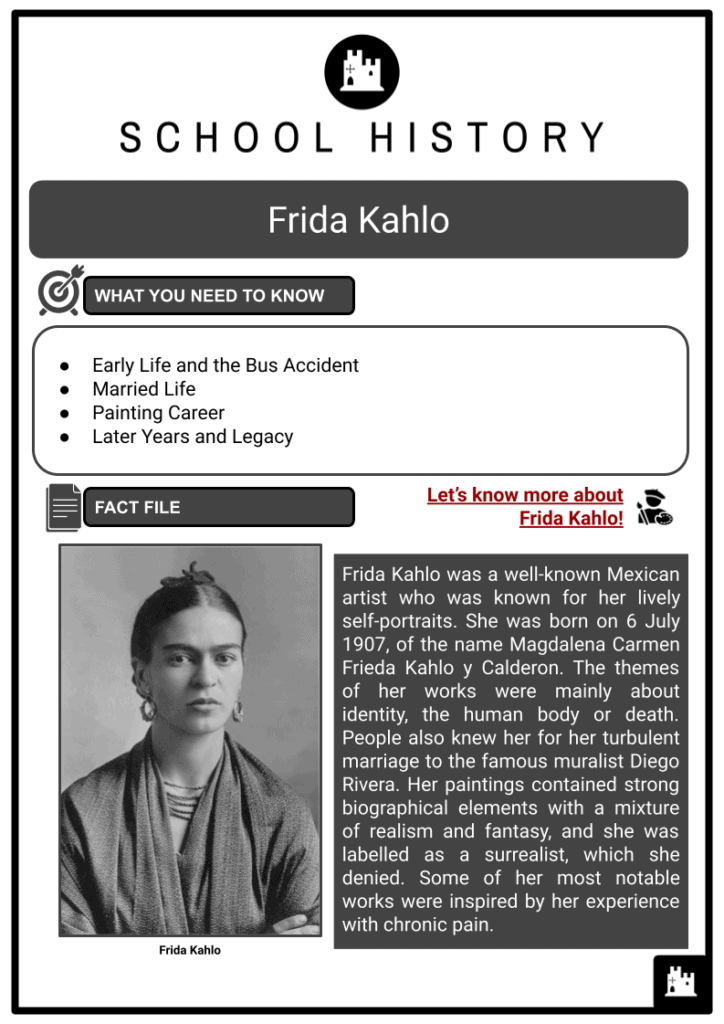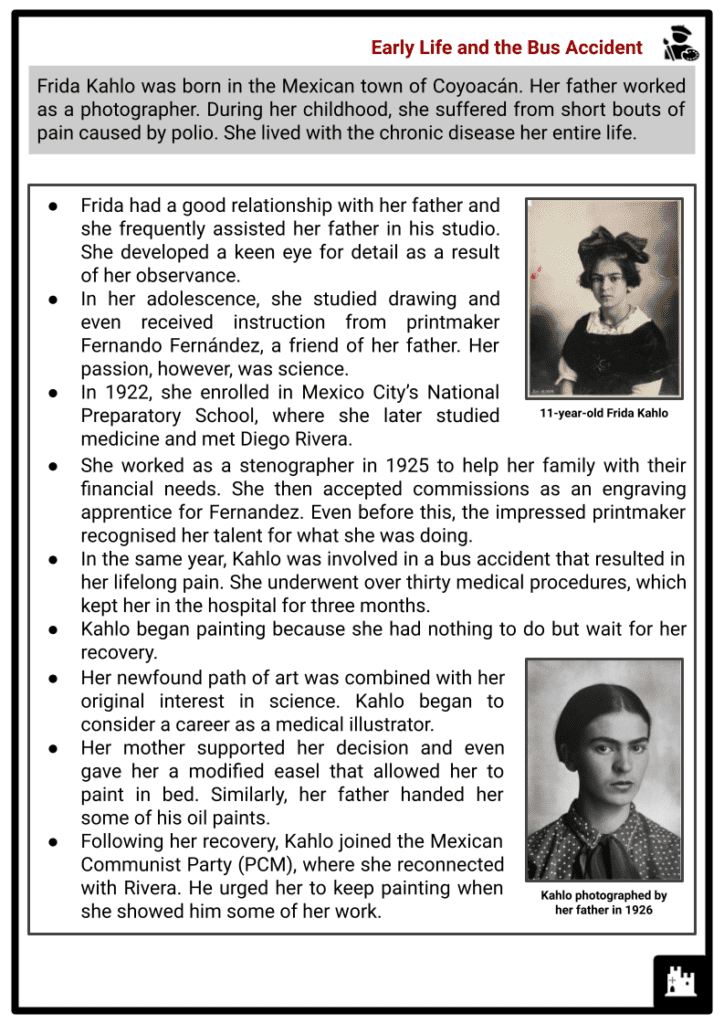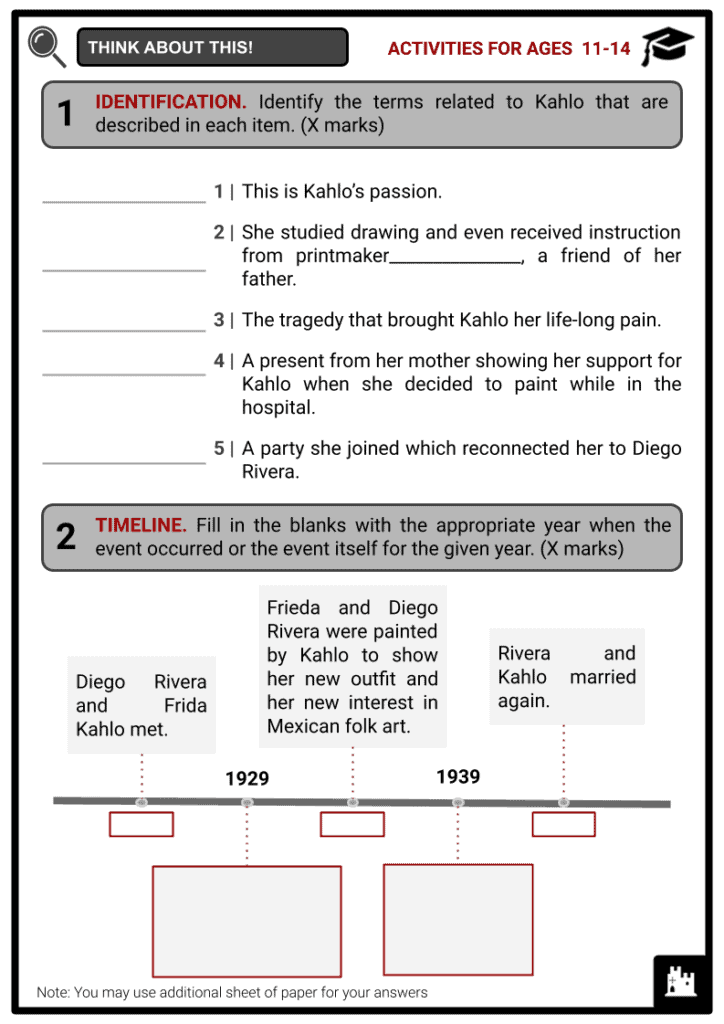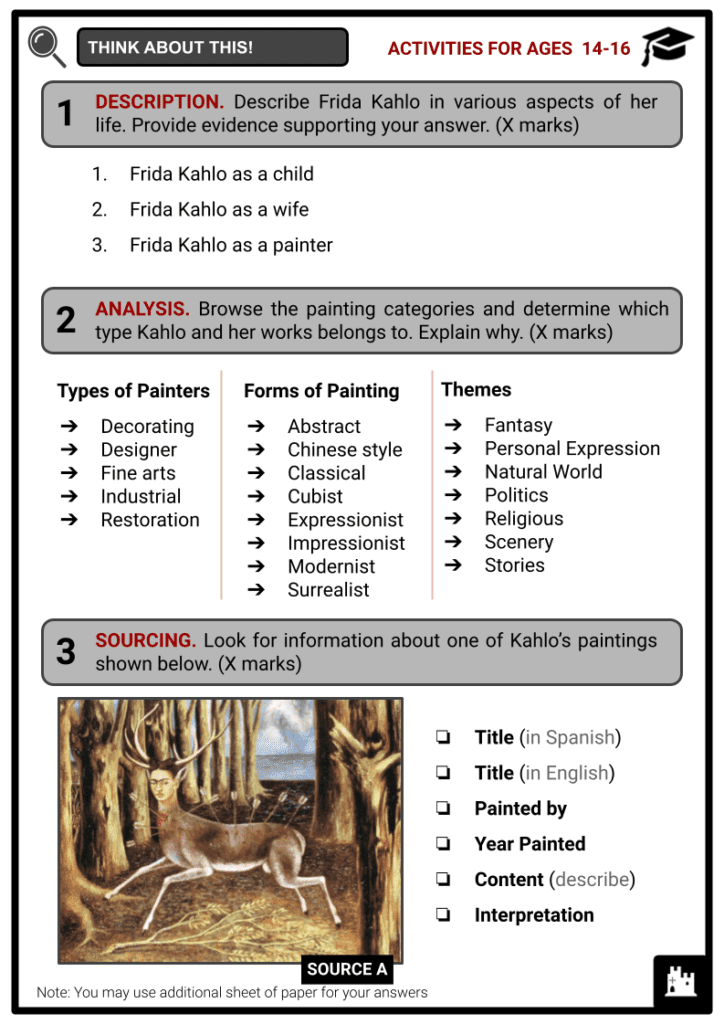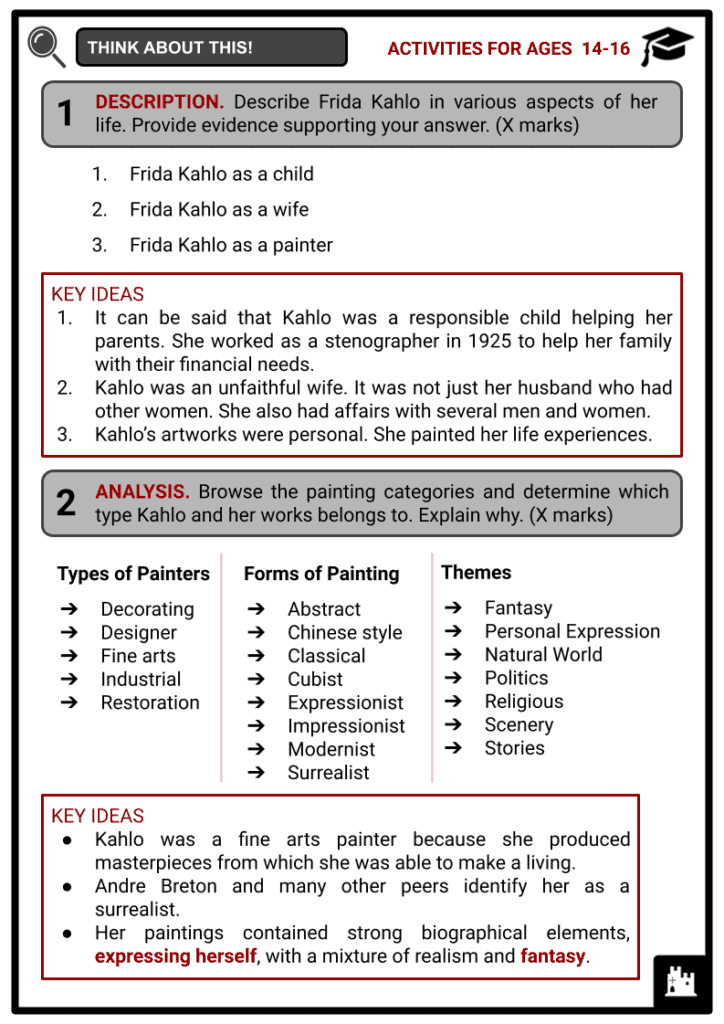Frida Kahlo Worksheets
Do you want to save dozens of hours in time? Get your evenings and weekends back? Be able to teach about Frida Kahlo to your students?
Our worksheet bundle includes a fact file and printable worksheets and student activities. Perfect for both the classroom and homeschooling!
Summary
- Early Life and the Bus Accident
- Married Life
- Painting Career
- Later Years and Legacy
Key Facts And Information
Let’s find out more about Frida Kahlo!
Frida Kahlo was a well-known Mexican artist who was known for her lively self-portraits. She was born on 6 July 1907, of the name Magdalena Carmen Frieda Kahlo y Calderon. The themes of her works were mainly about identity, the human body or death. People also knew her for her turbulent marriage to the famous muralist Diego Rivera. Her paintings contained strong biographical elements with a mixture of realism and fantasy, and she was labelled as a surrealist, which she denied. Some of her most notable works were inspired by her experience with chronic pain.
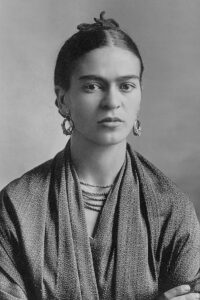
Early Life and the Bus Accident
- Frida Kahlo was born in the Mexican town of Coyoacán. Her father worked as a photographer. During her childhood, she suffered from short bouts of pain caused by polio. She lived with the chronic disease her entire life.
- Frida had a good relationship with her father and she frequently assisted her father in his studio. She developed a keen eye for detail as a result of her observance.
- In her adolescence, she studied drawing and even received instruction from printmaker Fernando Fernández, a friend of her father. Her passion, however, was science.
- In 1922, she enrolled in Mexico City’s National Preparatory School, where she later studied medicine and met Diego Rivera.
- She worked as a stenographer in 1925 to help her family with their financial needs. She then accepted commissions as an engraving apprentice for Fernandez. Even before this, the impressed printmaker recognised her talent for what she was doing.
- In the same year, Kahlo was involved in a bus accident that resulted in her lifelong pain. She underwent over thirty medical procedures, which kept her in the hospital for three months.
- Kahlo began painting because she had nothing to do but wait for her recovery.
- Her newfound path of art was combined with her original interest in science. Kahlo began to consider a career as a medical illustrator.
- Her mother supported her decision and even gave her a modified easel that allowed her to paint in bed. Similarly, her father handed her some of his oil paints.
- Following her recovery, Kahlo joined the Mexican Communist Party (PCM), where she reconnected with Rivera. He urged her to keep painting when she showed him some of her work.
Married Life
- In June 1928, Kahlo attended one of Modotti’s parties and met Diego Rivera. They had first met in school when Kahlo was 15 years old. Kahlo was curious if, for Rivera, her talent was sufficient to pursue a career as a painter. Rivera, on the other hand, was impressed by her work and stated that her paintings had “unusual energy of expression, precise delineation of character, and true severity... They had a fundamental plastic honesty and an artistic personality of their own... It was obvious to me that this girl was an authentic artist.”
- Kahlo entertained a romantic relationship with Rivera despite their twenty-year age difference and the fact that he already had two wives. On 21 August 1929, the two married in a civil ceremony at Kahlo’s hometown town hall.
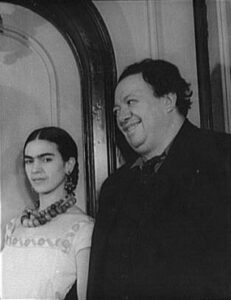
Kahlo and Rivera - Kahlo’s parents were opposed to the marriage and compared Rivera and Kahlo’s union to that of an elephant and a dove, based on their respective sizes. Nonetheless, Rivera was accepted as her father’s son-in-law.
- Kahlo needed expensive treatment and she was unable to work.
- Rivera was wealthy, so Kahlo’s father was confident that her daughter would be financially supported by her husband. Given Rivera’s popularity, the marriage drew media attention in Mexico.
- After their wedding, Kahlo’s personal and artistic style shifted. She began wearing traditional Tehuana clothing, which quickly became her trademark.
- Later in their wedding year, the couple relocated to Cuernavaca, Morelos. Rivera was hired to paint murals for the Palace of Cortes, and Kahlo supported him by resigning from the PCM.
- In 1931, Kahlo painted Frieda and Diego Rivera showing her new attire and her new interest in the folk art of Mexico.
- The marriage was plagued by third parties, most notably Rivera’s affair with her younger sister and her affairs with several men and women. It led to the couple’s divorce in 1939.
Painting Career
- Kahlo began to paint more while travelling with her husband in the United States from 1930 to 1933. Meanwhile, she experienced a couple of complications during her pregnancy, which ended without her having a child.
- She had a miscarriage in Detroit, which was followed by the death of her mother. Kahlo diverted her grief into a painting, resulting in some of her most harrowing works.
- In 1932, Kahlo painted Henry Ford Hospital, in which she imagined herself haemorrhaging on a hospital bed. It was followed by My Birth, in which she depicted a shrouded woman giving birth, that same year.
- Kahlo and her husband returned to Mexico in 1933.
- Their newly constructed house, which was intended as separate individual areas joined by a bridge, attracted public attention and became a meeting place for artists and political activists. They even entertained notable Surrealists Leon Trotsky and Andre Breton at their home.
- Kahlo had her first solo show at the Julien Levy Gallery in New York in 1938. It went well, and Breton dubbed her a self-taught Surrealist.
- Kahlo travelled to Paris the following year to exhibit her work. She met other Surrealists, including Marcel Duchamp.
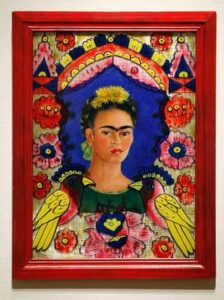
The Frame, a self-portrait by/of Kahlo - One of her works, The Frame, was displayed at the Louvre in Paris. This made Kahlo the first modern Mexican artist to be included in the museum’s collection.
- When Kahlo and Rivera divorced due to marital problems in 1939, she concentrated on painting some of her most famous works.
- She created The Two Fridas, which depicts twin figures holding each other’s hands. The figure on the left was dressed in a European-style wedding gown, while the other figure was dressed in her traditional Tehuana attire.
- The painting was said to represent her two opposing personalities, namely the one that her husband rejected (in a wedding gown) and the one that her husband adored the most.
- Her love of science was also evident in the painting, which included anatomy.
- In 1940, Kahlo and Rivera remarried. They relocated to La Casa Azul in Coyoacan.
- After three years, Kahlo was appointed as a painting professor at the Education Ministry’s La Esmeralda School of Fine Arts.
- Kahlo’s condition worsened, and she decided to seek relief from alcohol and drugs.
- Her painting career continued with numerous self-portraits expressing herself through various hair, clothing and iconography styles.
- During the early 1950s, Kahlo spent the majority of her days in the hospital intending to conduct surgeries. She eventually required walking assistance.
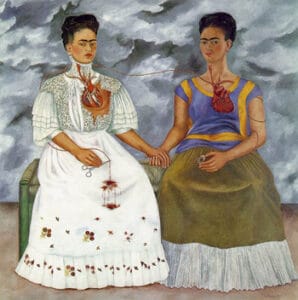
The Two Fridas - In 1951, she painted the Self-Portrait with Portrait of Dr Farill while seated in a wheelchair.
- Lola Alvarez Bravo, a photographer, predicted that Kahlo’s health would take her life soon. So she decided to organise Kahlo’s first solo exhibition in Mexico.
- It debuted in April 1953 at the Galeria Arte Contemporaneo.
- In the meantime, Kahlo’s doctors advised her to rest. This would make it difficult for her to attend the exhibition’s opening.
- As a result, she requested that her bed be relocated to the gallery. This allowed her to attend the opening and the whole party, although she was lying in her bed.
- The exhibition drew worldwide attention from the press.
- During the same year, five of her paintings were shown at the Tate Gallery in London.
Later Years and Legacy
- During her final years, Kahlo devoted her time to political activism. In 1948, she rejoined the PCM and campaigned for peace.
- Because of gangrene, her right leg had to be amputated at the knee in August 1953. It made her depressed and anxious, and it made her dependent on painkillers.
- Rivera began another affair, and when Kahlo discovered it, she attempted suicide by overdose.
- A diary dated February 1954 showed her entry saying,“They amputated my leg six months ago, they have given me centuries of torture and at moments I almost lost my reason. I keep on wanting to kill myself. Diego is what keeps me from it, through my vain idaea that he would miss me. ... But never in my life have I suffered more. I will wait a while…”
- Kahlo was mostly bedridden in her final days due to bronchopneumonia.
- She made her last public appearance on 2 July 1954, when she joined her husband in a protest against the CIA invasion of Guatemala.
- She talked to other visitors about her death as if she was expecting it.
- She also drew skeletons and angels in her diary with the last one being a black angel with the words “Espero Alegre la Salida - y Espero no Volver Jamás” (in English: “I joyfully await the exit - and I hope never to return - Frida”), which was interpreted as the Angel of Death by her biographer Hayden Herrera.
- Her condition worsened after she attended the protest.
- On the night of 12 July 1954, Kahlo experienced severe pain and a high fever. Despite this, she managed to give her husband a one-month early wedding anniversary gift.
- Her nurse discovered her body around 6 am the next day.
- Frida Kahlo died of a pulmonary embolism on 13 July 1954, at the age of 47.
- However, some people believe she committed suicide. The nurse counted her painkiller use as an overdose when she took four pills more than her maximum dose of seven pills, which supports this.
- Kahlo’s body was transferred to the Palacio de Bellas Artes on the evening of her death, and a Communist flag was draped over her.
- Her body was moved the next day to the Panteon Civil de Dolores, where her funeral was attended by friends and family.
- Kahlo’s body was cremated in accordance with her wishes, and her ashes were displayed in a pre-Columbian urn at La Casa Azul.
- After Kahlo’s death, Rivera turned La Casa Azul into a museum. Rivera died in 1958, and the Frida Kahlo Museum, to which he devoted his final three years, opened to the public.
- The Diary of Frida Kahlo, which Kahlo wrote from 1944, and The Letters of Frida Kahlo were published in 1995.
- Despite her death, Kahlo’s reputation grew steadily from the 1970s, giving rise to ‘Fridamania’ in the 21st century.
- The Frida Kahlo Museum has become one of Mexico City’s most popular museums, with over 25,000 visitors each month.
- Coyoacan created a park in her honour, the Parque Frida Kahlo, in 1985, with her bronze statue as the park’s main attraction.
- The United States honoured Kahlo with a postage stamp in 2001, making her the first Hispanic woman to have one.
- The Legacy Walk, an outdoor public demonstration in Chicago celebrating LGBT history and people, also recognised her in 2012.
- Kahlo was also portrayed on stage in several productions. Frida by Robert Xavier Rodriguez and Frida y Diego by Kalevi Aho were two operas inspired by her that premiered at the American Music Theatre Festival in Philadelphia in 1991 and the Helsinki Music Centre in Helsinki, Finland in 2014, respectively.
- Mattel released 17 new Barbie dolls in honour of International Women’s Day in 2018, including one of Kahlo. Critics criticised the doll’s slim waist and conspicuously absent unibrow.
Image Sources
- https://upload.wikimedia.org/wikipedia/commons/thumb/0/06/Frida_Kahlo%2C_by_Guillermo_Kahlo.jpg/800px-Frida_Kahlo%2C_by_Guillermo_Kahlo.jpg
- https://upload.wikimedia.org/wikipedia/commons/3/3a/Frida_Kahlo_Diego_Rivera_1932.jpg
- https://upload.wikimedia.org/wikipedia/en/2/21/The_Frame_%28Frida_Kahlo_painting%29.jpg
- https://upload.wikimedia.org/wikipedia/en/f/f9/The_Two_Fridas.jpg

